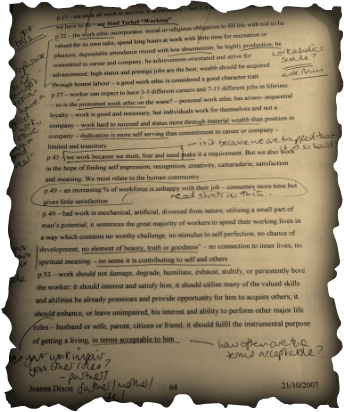How To Write Slam Poetry: A 9 Step Guide To Writing Your First Slam PoemPlease raise your hand if you've ever heard someone perform slam poetry, were blown away by it, and then asked yourself “How can I do that? How do I write a slam poem that rocks?" When you first hear an artist performing spoken word, you're overcome with an extraordinary sense of cultural fusion, killing any inkling of mundane, ambiguous and downright awful views you may have previously established about poetry as a genre. It's daunting enough to be forced into taking Lit or Poetry courses throughout school – never mind if your teacher or professor has asked the class to actually write and perform (GASP!) your work for the class! Well, there's good news: Writing your own slam poetry doesn't have to be a horrifying experience; you can be a captivating creator too! With the right passion and some ideas at your disposal, you could easily create an engaging slam poem -- all without feeling like it’s homework! Keep reading on, and we'll walk through how to create a good outline to get you started. When we're done you'll know exactly how to create a sexy slam poem that releases your passions, your beasts, your secrets – and your talents!! Ready? Let's dive in. Step by step guide on how to write a slam poem1. Outline your main story, your feelings and your message Before you start diving into any elements or the framework of your first slam poem, you need to get your story and ideas straight. Just like you would sharpen an ax before chopping down a tree, you want to establish the main story and the feelings or message you wish to convey to your audience before you start writing the lines (and chasing rhymes...I've seen a lot of poets try to rhyme before they have their story. Wrong approach). What you'll want to do is think about moments. This makes things simpler. Think of a moment that touched you, moved you, changed you...something that left an everlasting impression. Once you have that moment, you can write everything that surrounded it - this is the start of your story. Once you have that story, you can start jotting down examples, lines and ideas to support your story. Think about all the emotions that surrounded it. How did you feel? Now reach beyond that for details: Were there particular scents in the air? Did you touch something that you remember (e.g. "As I fell to the floor the carpet was sandpaper..."). Did you taste something, see something, hear something? The more you can incorporate sensory information into your piece, the more your audience will be able to relive it. Keep track of anything you might decide not to use in this poem so you have some creative ideas for later user (you don't need to elaborate on them just yet, but it’s good to have an ace up your sleeve when you realize you love writing slam poetry!). Keep in mind that this initial step shouldn't be complex. If you need some topic ideas for your piece, check out my blog for some goodies! 2. Decide on your style, tone & voice After you've established your storyline, figure out what type of flow you want your slam poem to take on. When you think about the style you’re going to use, keep in mind the story at hand. Is it sad? Is it upbeat? Is it confused? Try to pick a style that aligns with your tone to create a truly unique experience. Or, if you really want to go out on a limb, you can be sarcastic. For example, talk about a totally tragic event but in a happy light. I once saw a YouTube video that used a trailer for “The Shining” and mixed it with the typical “white picket fence” type of movie intro – hysterical! And creative (aren't slam poets creative?) Your style and flow should be unique to you. There are a lot of slam poets out there who try very hard to sound like the next poet. It can work…at times… it can also be a massive fail. So think about it – do you want to go free-form? Sound like a rapper? A monologue? A written letter? Or just a story with babbling? Whatever you choose as the style for your slam poem, I suggest going back to this step later to try your finished piece in other tones and with different types of delivery. Finally, style should include the poetic devices you want to use. Repetition, Imagery, Analogies, Rhyme, Alliteration, etc. are all tools that can enhance your piece and, more importantly, put some OOMPH! in your delivery! Here's a good resource for some poetic devices you might use: Poetic Devices
3. Write a first draft
Once you know what your story is and you have an idea of the style you want to take on, its time to get to writing. For beginners, you might try to write your poem like you're writing a short story. If possible, however, keep the sentences short and choppy. We've all heard poetry before, so don't take this on like you're oblivious. It's not going to be your final draft, but you want to put quality and a high caliber of thought and effort into this step. 
4. Edit your draft with details
Once you have a draft that conveys your message and suffices to tell the story you want people to hear, its time to add the Adobo! Go back to your work and first decide if its all in the right order. Often I move sentences or entire verses to different portions of the poem to add flow to my story. Now think about the types of poetic devices you can and wish to use. Are there areas you can infuse some of them? i.e. is there a fact in there that you can change to an analogy? Are there words you can swap for synonyms to complete a sentence with alliteration? Are there opportunities to create different kinds of rhymes? Think about the slam poetry you've heard and some of the parts of those poems that resonate with you. Were they using repetition or another tool? If it stuck with you, chances are its something that could make your poem more powerful. What you should ultimately be doing here is making your poem sound, well, poetic...for lack of a real definition. Your original draft should look like more marked up than a 3rd grader's essay. I say that because you don't want to erase your original lines (they might come in handy later), but rather keep your original thoughts and words, but use a different color pen or ink and start marking the page up like a teacher. So go 'head, get sloppy! *Note: If you use MS Word, Google Docs, or something like that, use "review" mode and work with showing markup 5. Rewrite a (near) final version Using the notes and ideas you just added to version one, re-pen your poem to a much cleaner, much "slammier" version. It shouldn't take long because your words, your ideas, your story, etc. - it's all there already. Once you have that version, begin to read it to yourself. As you're reading, think about your style and ask yourself "is this flowing the way I'd want to hear it?" This is prime-time for quick and dirty edits. You should be making a bunch of small changes, perhaps adding or taking away a couple lines... be sure you note everything! You should read and re-read this back 5 times. Then go away from your poem for at least 24 hours. THIS IS IMPORTANT! Come back to it the next day when you're in a different mood and mind frame, and re-read this version again. Go through the same exercise, changing words and really fine-tuning the piece.
6. Finalize your piece (i.e. round 1 stage ready)
Take all the notes you now have on your second version and formulate your stage version. Again, this shouldn't take long given you have all the assets.
7. Practice, Perform & Perfect!
Once you have your final version, its time to start reciting it out loud. I usually read my poems over a hundred times before ever performing. This allows me to understand my own intonation, to know where my emphasis is, to capture the pauses and line breaks so I have a flawless flow. You can use a recorder also for this part. Listen to yourself and make notes of things you want to change. With each recital of your piece, you should know more and more the perfect form for your delivery. 8. Memorize Don't get on stage with a piece of paper! You should be connecting with the audience when you deliver your message. If you're reading from a sheet, you are probably losing their attention quickly. Memorization isn't easy, but it really adds to the art of "spoken word". The "read word" (I made that up) is too much like your 17th Century Poetry bullshit class. You want to have a presence on stage. You're acting. You're living out your feelings. You're going to need your full body to do that - and your two hands. So memorize parts at a time - go from verse to verse. Then try connecting verses. It won't happen overnight, but I promise it will happen!
9. Slam Motherfucker, SLAM!
I've said it before and its my favorite part. Last but certainly not least, once you think you're ready, sign yourself up for a slam poetry competition. If you're scared, you can be slightly eased because the audience is forgiving. For things like open mic nights, they know they aren't there to see professionals. Slam poetry is a free-form art. The work is yours. The moment is yours. Eat that shit up. Oh, and practice will get you better at overcoming the butterflies and buckled knees known as stage fright. So if you don't think you were great your first time, practice with some of your buddies, continue to record yourself and get better. If you've really got a passion for slam, you can sharpen your scalpel! If you've had the pleasure of witnessing the Spoken Word and it moved you, hopefully you have some desire to do it yourself. But writing slam poetry can certainly seem intimidating. Hopefully with this guide, you can get yourself started. If you'd like some ideas for what to write your slam poem about I've put together some resources to help you out. Have fun! If this was useful, you might find some more help in these blogs:
1 Comment
|
|




